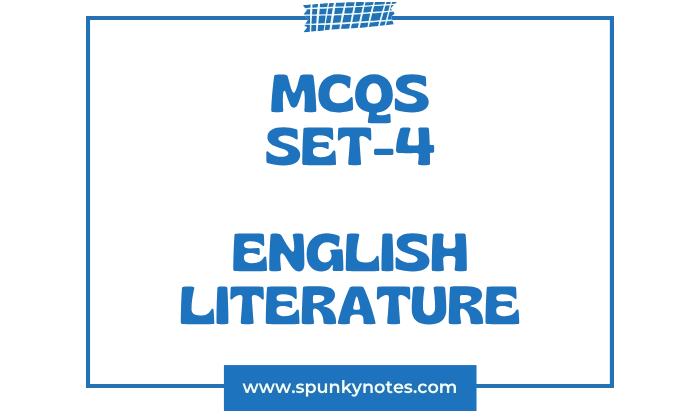

Estimated Reading Time: 16 min
English Literature MCQs
Set-4
1. Thomas More’s ‘Utopia’ was translated into English in
A. 1551
B. 1651
C. 1516
D. 1616
2. Philip Sidney’s ‘Astrophel and Stella’ is
A. a narrative poem
B. a prose romance
C. a tragedy
D. a collection of songs
3. How many pilgrims are mentioned in Chaucer’s The Canterbury Tales ?
A. 29
B. 30
C. 28
D. 31
4. What is the complete title of Marlowe’s play popularly known as ‘Dr. Faustus’?
A. The Life and Death of Dr. Faustus
B. The History of Dr. Faustus
C. The Lamentable Tragedy of Dr. Faustus
D. The Tragical History of Dr. Faustus
5. Which of the following arrangements is in the correct chronological order?
A. Hamlet, Othello, Lear, Macbeth
B. Hamlet, Lear, Othello, Macbeth
C. Othello, Hamlet, Macbeth, Lear
D. Lear, Hamlet, Othello, Macbeth
6. Milton’s final work is
A. Paradise Lost
B. Samson Agonistes
C. Paradise Regained
D. Comus
7. Webster’s ‘The White Devil’ is associated with –
A. Vittoria
B. Duches of Malfi
C. Bosola
D. Ferdinand
8. The writer of ‘The Honest Whore’ is –
A. Middleton
B. Dekker
C. Webster
D. Jonson
9. The Restoration comedy is known as
A. the comedy of manners
B. the sentimental comedy
C. the comedy of humours
D. the domestic comedy
10. In ‘Absalom and Achitophel’, Achitophel stands for
A. The Duke of Monmouth
B. The Earl of Sunderland
C. The Earl of Essex
D. The Earl of Shaftesbury
11. The word ‘sense’ for the Eighteenth century English scholars meant
A. an individual opinion
B. a feeling or emotion
C. the opposite of reason
D. an inherent power to tell true from false
12. The objective of The Spectator was
A. to satirize all political parties
B. to entertain and distract
C. to educate
D. to provide news
13. Uncle Toby is a character in
A. Pamela
B. Joseph Andrews
C. Tom Jones
D. Tristram Shandy
14. ‘Each in his narrow cell for ever laid / The rude forefathers of the hamlet sleep’ These Lines are taken from
A. The Deserted Village
B. Ode on a Distant Prospect of Eton College
C. Elegy written in a Country Churchyard
D. The Vanity of Human Wishes
15. She Stoops to Conquer is
A. a sentimental comedy
B. an anti-sentimental comedy
C. a domestic comedy
D. a comedy of humours
16. ‘Heard melodies are sweet but those unheard are sweeter’. These lines are written by
A. John Keats
B. P. B. Shelley
C. S. T. Coleridge
D. William Wordsworth
17. Biographia Literaria was published in
A. 1817
B. 1827
C. 1798
D. 1805
18. ‘O Rose, thou art sick! / The invisible worm, / That files in the night, / In the howling storm’ These lines are written by
A. Alfred, Lord Tennyson
B. John Keats
C. William Blake
D. S. T. Coleridge
19. The phrase ‘willing supension of disbelief’ is associated with
A. Keats
B. Wordsworth
C. Shelley
D. Coleridge
20. Who considers William Wordsworth the third greatest poet in English after Shakespeare and Milton ?
A. T. S. Eliot
B. Arnold
C. F. R. Leavis
D. Harold Bloom
21. Michael Henchard is a character from a novel by –
A. Thomas Hardy
B. George Eliot
C. Charles Dickens
D. Jane Austen
22. Which of the following arrangements is in the correct chronological sequence?
A. Bleak House, Hard Times, Great Expectation, A Tale of Two Cities
B. Hard Times, Bleak House, A Tale of Two Cities, Great Expectations
C. Bleak House, Hard Times, Great Expectation, A Tale of Two Cities
D. Hard Times, Great Expectations, A Tale of Two Cities, Bleak House
23. Maggie Tulliver is a character in
A. The Mill on the Floss
B. Middlemarch
C. Daniel Deronda
D. Adam Bede
24. “For the world which seems / To lie before us like a land of dreams, / So various, so beautiful, so new, / Hath really neither joy, nor love, not light, / Nor attitude, not peace, not help for pain; These lines are written by
A. Arnold
B. Tennyson
C. Browning
D. Swinburne
25. The Subjection of Women was written by
A. Thomas Carlyle
B. J.S. Mill
C. Charles Dickens
D. Walter Pater
26. ‘Mistah Kurtz he dead’. These words are spoken in
A. The Heart of the Matter
B. The Secret Sharer
C. Lord Jim
D. Heart of Darkness
27. The Marbar Caves in A Passage to India echo
A. the silence of the earth
B. the futility of love
C. ‘ou-boun’
D. the sound of despair
28. Tiresia appears in
A. The Second Coming
B. Ulysses
C. The Waste Land
D. The Love Song of J. Alfred Prufrock
29. Point Counter Point is
A. a political novel
B. a love story
C. a satirical romance
D. a discussion novel
30. Which of the following novels does not use the technique of the stream of consciousness?
A. Ulysses
B. To the Lighthouse
C. Mrs. Dalloway
D. Sons and Lovers
31. Waiting for Godot was published in
A. 1950
B. 1952
C. 1953
D. 1954
32. Harold Pinter is associated with
A. The Theatre of the Absurd
B. The Angry Young Men Movement
C. Neoclassicism
D. Sentimental Drama
33. Lord of the Flies is
A. a fable
B. a thriller
C. a fairy tale
D. a romance
34. Now and then a smell of grass / Displaced the reek of buttoned carriage cloth / Until the next town, new and non descript / These lines are taken from
A. The Less Deceived
B. High Windows
C. The Whitsun Weddings
D. The North Ship
35. David Lodge is a
A. modernist
B. postmodernist
C. metaphysical poet
D. romantic novelist
36. In Walden Thoreau criticises
A. the materialistic approach to life
B. the political corruption
C. the lack of natural beauty
D. the excessive technology
37. In The Leaves of Grass Walt Whitman sings songs of
A. communism
B. democracy
C. aristocracy
D. war
38. Hester Prynne is a character from
A. Moby Dick
B. The Custom House
C. The Scarlet Letter
D. The Blithedale Romance
39. “The Fall of the House of Usher” is by
A. Herman Melville
B. Washington Irving
C. Nathaniel Hawthorne
D. Edgar Allen Poe
40. Disgrace is written by
A. J.M. Coetzee
B. Nadine Gordimer
C. Chinua Achebe
D. Wole Soyinka
41. Plato wanted to judge poetry from the tool of
A. Beauty
B. Emotion
C. Truth
D. Form
42. The function of tradegy, according to Aristotle, is to offer
A. purgation of emotions
B. recognition and reversal
C. moral instruction
D. tragic pleasure
43. ‘The poet is a man speaking to man’. Who wrote this?
A. S. T. Coleridge
B. T. S. Eliot
C. Wordsworth
D. Matthew Arnold
44. Rasa Theory was first expounded by
A. Dhananjaya
B. Abhinavagupta
C. Bharat Muni
D. Jagannatha
45. ‘Death of the Author’ emphasises
A. author’s intent
B. historical context
C. literary form
D. reader
46. Identify the figure of speech in the following line: “It is an open secret”
A. Pun
B. Simile
C. Oxymoron
D. Metaphor
47. Match the following: a. Innuendo, b. Parable, c. Onomatopoeia, d. Oxymoron with I figure based on difference, II figure based on sound, III figure based on indirectness, IV figure based on similarity
A. a-I, b-II, c-III, d-IV
B. a-II, b-I, c-IV, d-III
C. a-IV, b-III, c-II, d-I
D. a-III, b-IV, c-II, d-I
48. Identify the figure of speech – “Our birth is but a sleep and a forgetting”
A. Metaphor
B. Simile
C. Apostrophe
D. Personification
49. A Petrarchan sonnet is divided as follows –
A. Three Quatrains and a Couplet
B. A Sestet followed by an Octave
C. Two Quatrains and two Tercets
D. An Octave followed by a Sestet
50. Match the following: a. iambic b. anapestic c. trochaic d. dactylic
A. a-II, b-III, c-IV, d-I
B. a-IV, b-I, c-III, d-II
C. a-I, b-II, c-III, d-IV
D. a-III, b-II, c-I, d-IV
Overview
This set of 50 multiple-choice questions begins with the Renaissance (More, Sidney) and Medieval (Chaucer) periods. It moves through Shakespeare, Milton, and Restoration comedy.
The 18th century is tested with questions on Dryden, The Spectator, and Thomas Gray. The Romantic period follows, with a focus on Keats, Blake, and Coleridge. The Victorian section includes authors such as Hardy, Dickens, George Eliot, and Matthew Arnold.
The 20th century is represented by Modernists (Conrad, T.S. Eliot, Huxley), Absurdists (Beckett, Pinter), and post-war poets (Larkin).
A section on American literature (Thoreau, Whitman, Poe, Hawthorne) is also included. The test concludes with questions on literary theory (Plato, Aristotle, Barthes) and poetic devices (oxymoron, sonnet structure, and metrical feet).


